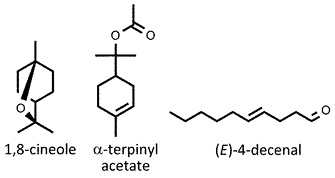 Elettaria cardamomum
Elettaria cardamomum
cardamom
Back to “Spices: cardamom (Elettaria cardamomum)fr, s”
Elettaria cardamomum (L.) Maton (Zingiberaceae); kardamom (Afrikaans); kardemumma (Finnish); cardamome (French); Kardamom (German); ilaayacii (Hindi); cardamomo (Italian); karadamomo (Japanese); cardamomo (Portuguese, Spanish); kardemumma (Swedish); aila cheddi (Tamil); luk grawan (Thai); kakule (Turkish)
DESCRIPTION Small, near-ripe fruits (three-valved capsules) containing numerous dark brown seeds. They are green in colour when simply air-dried but may be pure white as a result of bleaching with steam or sulphur before drying.1 There are several other spices known as cardamom.1,2 The large brown fruits of black cardamom, derived from Amomum subulatum (Nepal cardamom), is popular in India and Pakistan for flavouring savoury dishes. The brown colour results from the partial roasting and smoking of the fruits when they are dried over open fires. Even larger are the fruits of A. costatum (Chinese black cardamom), which is important in Sichuan and Vietnamese cuisine.
THE PLANT A tall perennial herb with erect stems bearing broad leaves and horizontal flowering stems bearing clusters of white and pink flowers at ground level.1
ORIGIN Cardamom is indigenous to the forests of India and Sri Lanka, where it has been wild-harvested for centuries.1,2 Along with black pepper and dried ginger, this “queen of spices” formed the bulk of the oriental spice trade since the third century BC. In the modern era it has become an important crop, with Guatemala as the main producer (5 000 tons per annum), followed by India (4 000 tons).2 Minor producers include Tanzania, Sri Lanka and Papua New Guinea.2
CULTIVATION Cultivated cardamom does not differ from the wild type. Plants can be propagated from seeds or by division. They require a tropical climate and thrive at higher latitudes in the shade of forest trees. Plants do not respond well to fertilization (it lowers the quality) but irrigation during the dry season improves the yield.2
HARVESTING Near-ripe fruits are usually hand-picked individually but the whole cluster is sometimes harvested, thus sacrificing the immature fruits.
CULINARY USES The delicious sweetish and pungent taste of cardamom has found its way into many different culinary traditions. In its native India, cardamom forms an important component of curries and curry powders. It is also widely used in rice, vegetable and meat dishes, as well as sweet desserts. The seeds are traditionally used to flavour Arabian coffee and black Turkish tea.3 In Europe and America, cardamom is well known as an essential ingredient of gingerbread and sweet pastries. Scandinavians (especially Swedes and Finns) are particularly fond of cardamom and large amounts are used in confectionery, desserts, stewed fruits, mulled wines, meat dishes and sausages.3 Ground cardamom is added to hamburger patties and meatloaf – one teaspoon per kg (2.2 lb.), while roughly bruised seeds are used in sausages as well as in breads, buns and brioches.3
FLAVOUR COMPOUNDS The essential oil contains 1,8-cineole (eucalyptol) and α-terpinyl acetate as major compounds, but the typical aroma of cardamom is ascribed to trace amounts of unsaturated aliphatic aldehydes such as (E)-4-decenal.4

NOTES For Ethiopian cardamom (korarima), see Aframomum corrorima.
1. Burkill, I.H. 1966. A dictionary of the economic products of the Malay Peninsula, Vol. 1, pp. 910–915. Crown Agents for the Colonies, London.
2. Nayar, N.M., Ravindran, P.N. 1995. Herb spices. In: Smartt, J., Simmonds, N.W. (Eds), Evolution of crop plants (2nd ed.), pp. 491–494. Longman, London.
3. Swahn, J.O., 1999. The lore of spices. Senate Publishing, London.
4. Noleau, I., Toulemonde, B., Richard, H. 1987. Volatile constituents of cardamom (Elettaria cardamomum) cultivated in Costa Rica. Flavour and Fragrance Journal 2: 123–127.